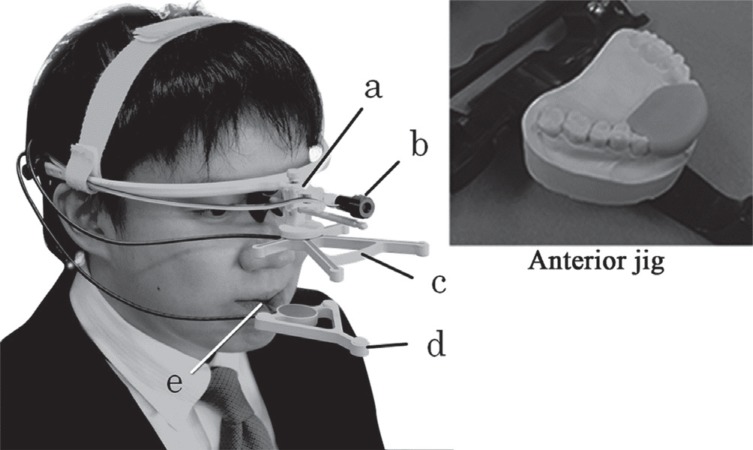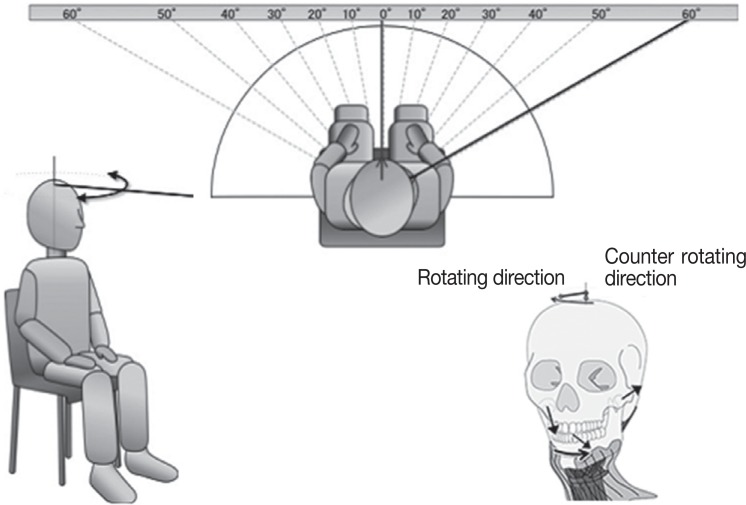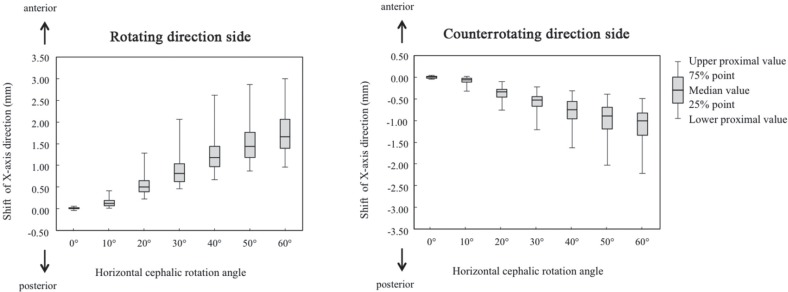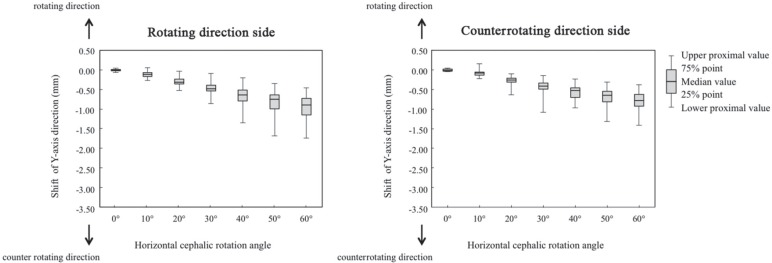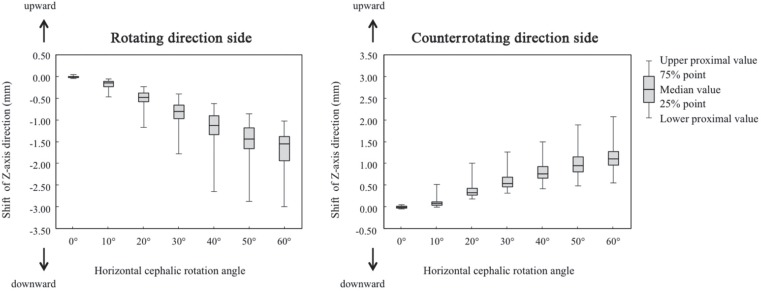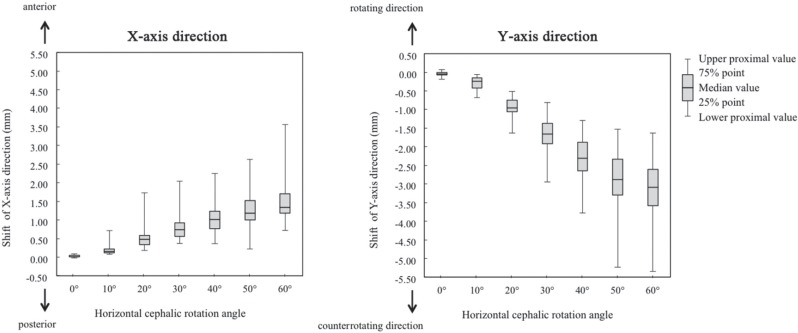J Adv Prosthodont.
2018 Dec;10(6):401-407. 10.4047/jap.2018.10.6.401.
The influence of horizontal cephalic rotation on the deviation of mandibular position
- Affiliations
-
- 1Functional Occlusal Treatment, The Nippon Dental University Graduate School of Life Dentistry at Niigata, Niigata, Japan.
- 2Removable Prosthodontics, The Nippon Dental University School of Life Dentistry at Niigata, Niigata, Japan. fumichan@ngt.ndu.ac.jp
- 3Comprehensive Dental Care, The Nippon Dental University Niigata Hospital, Niigata, Japan.
- KMID: 2429372
- DOI: http://doi.org/10.4047/jap.2018.10.6.401
Abstract
- PURPOSE
When performing an occlusal procedure, it is recommended that the patient should be sitting straight with the head in a natural position. An inappropriate mandibular position caused by an incorrect occlusal record registration or occlusal adjustment can result in damaged teeth and cause functional disorders in muscles and temporomandibular joints. The purpose of this study was to clarify the influence of horizontal cephalic rotation on mandibular position by investigating the three-dimensional positions of condylar and incisal points.
MATERIALS AND METHODS
A three-dimensional jaw movement measurement device with six degrees of freedom (the WinJaw System) was used to measure condylar and incisal points. The subjects were asked to sit straight with the head in a natural position. The subjects were then instructed to rotate their head horizontally 0°, 10°, 20°, 30°, 40°, 50°and 60° in the right or left direction.
RESULTS
The results indicated that horizontal cephalic rotation made the condyle on the rotating side shift forward, downward, and toward the inside, and the condyle on the counter rotating side shift backward, upward, and toward the outside. Significant differences in deviations were found for angles of rotation higher than 20°. The incisal point shifted in the forward and counterrotating directions, and significant differences were found for angles of rotation higher than 20°.
CONCLUSION
The mandibular position was altered by horizontal cephalic rotations of more than 20°. It is essential to consider the possibility of deviation of the mandibular position during occlusal procedures.
Keyword
Figure
Reference
-
1. Sasaki K, Watanabe M, Inai T, Kanuma A. Change of mandibular position elicited by tonic neck reflex under EMG biofeedback. J Dent Res. 1984; 63:556.2. Tingey EM, Buschang PH, Throckmorton GS. Mandibular rest position: a reliable position influenced by head support and body posture. Am J Orthod Dentofacial Orthop. 2001; 120:614–622. PMID: 11742306.
Article3. van't Spijker A, Creugers NH, Bronkhorst EM, Kreulen CM. Body position and occlusal contacts in lateral excursions: a pilot study. Int J Prosthodont. 2011; 24:133–136. PMID: 21479279.4. Coelho MF, Cavalcanti Bd, Claro Neves AC, Jóias RP, Rode Sde M. Influence of dental chair backrest inclination on the registration of the mandibular position. J Prosthet Dent. 2015; 114:693–695. PMID: 26344187.
Article5. Ohta A, Ishigami Y, Koide K, Hatate S, Kojima T, Tsugawa T, Takahashi J. A study on the horizontal reference plane in prosthodontics: The relationship among various reference planes. Shigaku. 1996; 84:68–73.6. Ishii M, Koide K, Ueki M, Asanuma N. Influence of body and head posture on deviation of the incisal point undergoing dental treatment. Prosthodont Res Pract. 2007; 6:217–224.
Article7. Xia JJ, McGrory JK, Gateno J, Teichgraeber JF, Dawson BC, Kennedy KA, Lasky RE, English JD, Kau CH, McGrory KR. A new method to orient 3-dimensional computed tomography models to the natural head position: a clinical feasibility study. J Oral Maxillofac Surg. 2011; 69:584–591. PMID: 21353923.
Article8. Nakajima Y, Koide K, Arakawa I, Koide K. Influence of lateral head tilt on mandibular position. Ann Jpn Prosthodont Soc. 2014; 6:300–308.
Article9. Hatano Y, Sakai T, Marumo Y, Tage T, Morimoto C, Suzuki M, Yokozuka S. Horizontal head posture of patients seating on the dental chair. Shigaku. 1997; 85:247–250.10. Krogh-Poulsen WG, Olsson A, Schwartz L, Chayes CM. Management of the occlusion of the teeth. Facial Pain Mandibular Dysfunction. 1968. p. 236–280.11. Lerman MD. The muscle engram: the reflex that limits conventional occlusal treatment. Cranio. 2011; 29:297–303. PMID: 22128670.
Article12. Goldstein DF, Kraus SL, Williams WB, Glasheen-Wray M. Influence of cervical posture on mandibular movement. J Prosthet Dent. 1984; 52:421–426. PMID: 6592342.
Article13. Fuentes MA, Opperman LA, Buschang P, Bellinger LL, Carlson DS, Hinton RJ. Lateral functional shift of the mandible: Part I. Effects on condylar cartilage thickness and proliferation. Am J Orthod Dentofacial Orthop. 2003; 123:153–159. PMID: 12594421.
Article14. Baqaien MA, Barra J, Muessig D. Computerized axiographic evaluation of the changes in sagittal condylar path inclination with dental and physical development. Am J Orthod Dentofacial Orthop. 2009; 135:88–94. PMID: 19121506.
Article15. Giannakopoulos NN, Wirth A, Braun S, Eberhard L, Schindler HJ, Hellmann D. Effect of the occlusal profile on the masticatory performance of healthy dentate subjects. Int J Prosthodont. 2014; 27:383–389. PMID: 25010884.
Article16. Funakoshi M, Amano N. Effects of the tonic neck reflex on the jaw muscles of the rat. J Dent Res. 1973; 52:668–673. PMID: 4515844.
Article17. Izutani Y. The clinical significance of the mandibular position regulated by myo-pulses. J Jpn Prosthodont Soc. 1980; 24:470–485.
Article18. Winnberg A, Pancherz H, Westesson PL. Head posture and hyo-mandibular function in man. A synchronized electromyographic and videofluorographic study of the open-close-clench cycle. Am J Orthod Dentofacial Orthop. 1988; 94:393–404. PMID: 3055938.19. Kuraishi M, Yazawa M, Yamada T. The change of teeth contacts according to the head position-Reproducing teeth contacts on the Hanau 145-2 Articulator. JNADT. 1997; 18:112–116.20. Youdas JW, Garrett TR, Suman VJ, Bogard CL, Hallman HO, Carey JR. Normal range of motion of the cervical spine: an initial goniometric study. Phys Ther. 1992; 72:770–780. PMID: 1409874.
Article21. Bexander CS, Mellor R, Hodges PW. Effect of gaze direction on neck muscle activity during cervical rotation. Exp Brain Res. 2005; 167:422–432. PMID: 16193272.
Article22. Karl PJ, Foley TF. The use of a deprogramming appliance to obtain centric relation records. Angle Orthod. 1999; 69:117–124. PMID: 10227551.23. Beyron H. Orienteringsproblem vid protetiska rekonstruktioner och Bettstudier. Svensk tandlak Tskr. 1942; 35:1–55.24. Kordaß B, Ruückert B, Stuüttgen U. Zur Länge und Lage der Interkondylarachse. Deutsche Zahnärztliche Zeitschrift. Dtsch ZahnaäZrztl Z. 1997; 52:1–4.25. Koide K, Koide K, Mizuhashi F, Takahashi M. Influence of opening and closing movements without any tooth contact on deviation of condylar position in mouth closing. Ann Jpn Prosthodont Soc. 2014; 6:414–422.
Article
- Full Text Links
- Actions
-
Cited
- CITED
-
- Close
- Share
- Similar articles
-
- The Effect of Bilateral Superior Oblique Tenotomy on Primary Position Horizontal Alignment
- Skeletal relapse pattern after sagittal split ramus osteotomy of mandibular prognathic patient
- Influence of Head Position in Rotation Test
- Operations on Vertical Rectus Muscles: Their Influence on Horizontal Strabismus
- Effects of vertical head rotation on the posteroanterior cephalometric measurements

